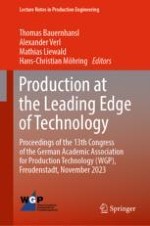The German Academic Association for Production Technology (WGP) annually invites researchers coming from its institutes and from industry to contribute peer reviewed papers in the field of production technology. This congress proceedings provides recent research results and findings on leading-edge manufacturing processes. Main aim of this scientific congress is to push forward existing borders in production and to provide novel solutions of "Production at the Leading Edge of Manufacturing Technology.
The subtitle “Technology-Based Sustainable Production for Circular Economy” of this year’s congress emphasizes challenges for global productions in the light of climate change and resource scarcity. Different sessions were held on the topics
Environmentally neutral production (e.g. energy and material efficiency)Resilient Value Creation SystemsBiointelligenceDigitization as an Enabler for Sustainable ProductionProduction Technologies for a Circular Economy
